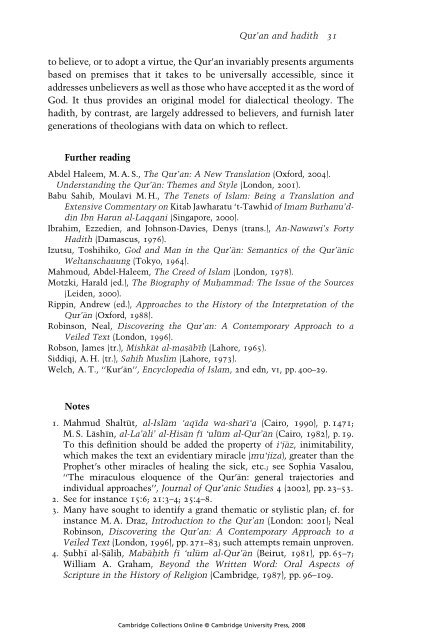Abdal Hakim Murad - The Cambridge Companion to Islamic Theology
Create successful ePaper yourself
Turn your PDF publications into a flip-book with our unique Google optimized e-Paper software.
Qur’an and hadith 31<br />
<strong>to</strong> believe, or <strong>to</strong> adopt a virtue, the Qur’an invariably presents arguments<br />
based on premises that it takes <strong>to</strong> be universally accessible, since it<br />
addresses unbelievers as well as those who have accepted it as the word of<br />
God. It thus provides an original model for dialectical theology. <strong>The</strong><br />
hadith, by contrast, are largely addressed <strong>to</strong> believers, and furnish later<br />
generations of theologians with data on which <strong>to</strong> reflect.<br />
Further reading<br />
Abdel Haleem, M. A. S., <strong>The</strong> Qur’an: A New Translation (Oxford, 2004).<br />
Understanding the Qur’an: <strong>The</strong>mes and Style (London, 2001).<br />
Babu Sahib, Moulavi M. H., <strong>The</strong> Tenets of Islam: Being a Translation and<br />
Extensive Commentary on Kitab Jawharatu ‘t-Tawhid of Imam Burhanu’ddin<br />
Ibn Harun al-Laqqani (Singapore, 2000).<br />
Ibrahim, Ezzedien, and Johnson-Davies, Denys (trans.), An-Nawawi’s Forty<br />
Hadith (Damascus, 1976).<br />
Izutsu, Toshihiko, God and Man in the Qur’an: Semantics of the Qur’anic<br />
Weltanschauung (Tokyo, 1964).<br />
Mahmoud, Abdel-Haleem, <strong>The</strong> Creed of Islam (London, 1978).<br />
Motzki, Harald (ed.), <strong>The</strong> Biography of Muh _<br />
ammad: <strong>The</strong> Issue of the Sources<br />
(Leiden, 2000).<br />
Rippin, Andrew (ed.), Approaches <strong>to</strong> the His<strong>to</strong>ry of the Interpretation of the<br />
Qur’an (Oxford, 1988).<br />
Robinson, Neal, Discovering the Qur’an: A Contemporary Approach <strong>to</strong> a<br />
Veiled Text (London, 1996).<br />
Robson, James (tr.), Mishkat al-mas _<br />
abıh _<br />
(Lahore, 1965).<br />
Siddiqi, A. H. (tr.), Sahih Muslim (Lahore, 1973).<br />
Welch, A. T., ‘‘K _<br />
ur’an’’, Encyclopedia of Islam, 2nd edn, vi, pp. 400–29.<br />
Notes<br />
1. Mahmud Shaltut, al-Islam ‘aqıda wa-sharı‘a (Cairo, 1990), p. 1471;<br />
M. S. Lashın, al-La’ali’ al-H _<br />
isan fı ‘ulum al-Qur’an (Cairo, 1982), p. 19.<br />
To this definition should be added the property of i‘jaz, inimitability,<br />
which makes the text an evidentiary miracle (mu‘jiza), greater than the<br />
Prophet’s other miracles of healing the sick, etc.; see Sophia Vasalou,<br />
‘‘<strong>The</strong> miraculous eloquence of the Qur’an: general trajec<strong>to</strong>ries and<br />
individual approaches’’, Journal of Qur’anic Studies 4 (2002), pp. 23–53.<br />
2. See for instance 15:6; 21:3–4; 25:4–8.<br />
3. Many have sought <strong>to</strong> identify a grand thematic or stylistic plan; cf. for<br />
instance M. A. Draz, Introduction <strong>to</strong> the Qur’an (London: 2001); Neal<br />
Robinson, Discovering the Qur’an: A Contemporary Approach <strong>to</strong> a<br />
Veiled Text (London, 1996), pp. 271–83; such attempts remain unproven.<br />
4. S _<br />
ubh _<br />
ı al-S _<br />
alih _<br />
, Mabah _<br />
ith fı ‘ulum al-Qur’an (Beirut, 1981), pp. 65–7;<br />
William A. Graham, Beyond the Written Word: Oral Aspects of<br />
Scripture in the His<strong>to</strong>ry of Religion (<strong>Cambridge</strong>, 1987), pp. 96–109.<br />
<strong>Cambridge</strong> Collections Online © <strong>Cambridge</strong> University Press, 2008



